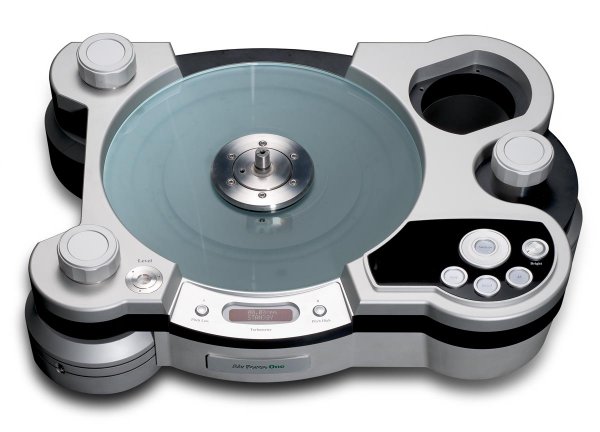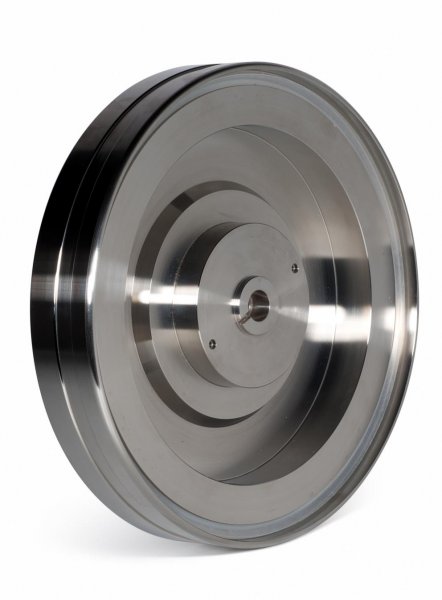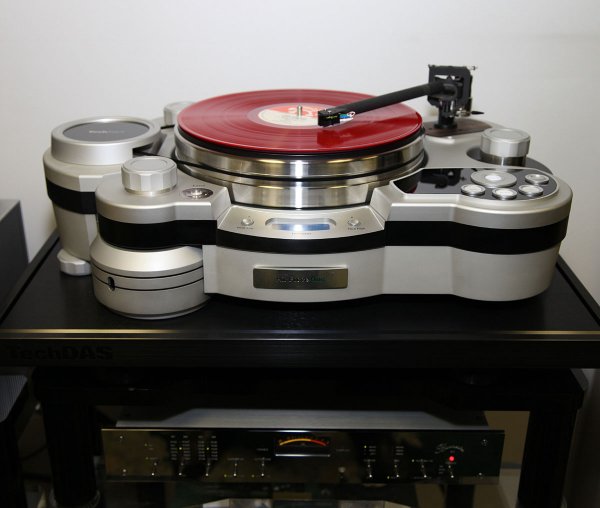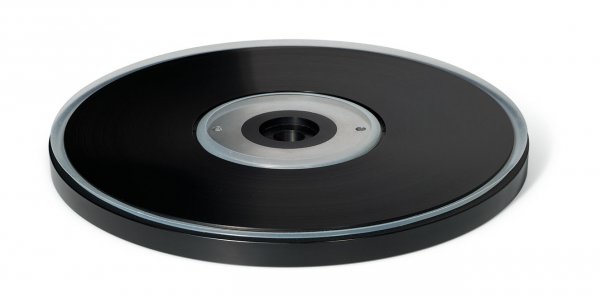TechDas Air Force One
- Thread starter wizard
- Start date
You are using an out of date browser. It may not display this or other websites correctly.
You should upgrade or use an alternative browser.
You should upgrade or use an alternative browser.
Peter,
in Munich it had plastic parts, so they might have changed it - good! A very good concept for a belt driven table like the Micros or the TechDas is trying eliminating or balancing the vector force which comes to existance by a motor drawing on one side. Therefore a design allowing to use a second motor on the right side is a technological step forward. Micro Seiki used to do this by a flywheel concept with the H 80. As I know the designer of the TechDas has some roots from the fomer Micro Seiki company in Japan. Maybe you can ask him what he thinks regarding this topic.
I had the Goldmund Reference I , I have heard the Clearaudio Master Reference and the Transrotor Gravita you are mentioning. Really good tables. Nevertheless those designs have disadvantages, too. But which table is really perfect?
Peter, is the airbearing system better than at a Micro Seiki SX 8000 II or at a Bergmann Sindre? What kind of motor is used?
Best
in Munich it had plastic parts, so they might have changed it - good! A very good concept for a belt driven table like the Micros or the TechDas is trying eliminating or balancing the vector force which comes to existance by a motor drawing on one side. Therefore a design allowing to use a second motor on the right side is a technological step forward. Micro Seiki used to do this by a flywheel concept with the H 80. As I know the designer of the TechDas has some roots from the fomer Micro Seiki company in Japan. Maybe you can ask him what he thinks regarding this topic.
I had the Goldmund Reference I , I have heard the Clearaudio Master Reference and the Transrotor Gravita you are mentioning. Really good tables. Nevertheless those designs have disadvantages, too. But which table is really perfect?
Peter, is the airbearing system better than at a Micro Seiki SX 8000 II or at a Bergmann Sindre? What kind of motor is used?
Best
garylkoh
WBF Technical Expert (Speakers & Audio Equipment)
Wow, this table is the new KING. I had my hands all over it yesterday and it is a tour de technical force, or I should say "air" force. HP told me that he thinks it may be the best in the world. I had a private session with it and Bob Graham yesterday and to say I was impressed would be mild. The table is dead quite (HP says this is the number one attribute), the vacuum is dead silent, rapping the side of the table while the recording is playing is amazing... no noise through the system. None nadda nothin honey.
Please keep a drool cloth handy if you are lucky enough to see one. Two units will be at CES- in the Genesis and Lamm suites. If Harvey were alive he'd say bring a ginty.
View attachment 7058
Peter, glad you had a chance to listen to it. First time I ever heard it, it knocked my socks off. You can even rap your knuckles on the record just ahead of the stylus while it is playing, and you won't hear the knocking! I'll be sure to have plenty of drool cloths handy for visitors.
Here's an "under the hood" picture I haven't yet seen online. It shows the float glass base of the air bearing. The mirror-polished platter base is supported on a cushion of air. The center spindle is for centering only and is slightly conical. Seems that the "secret" is in the huge size of the bearing.

garylkoh
WBF Technical Expert (Speakers & Audio Equipment)
Peter,
in Munich it had plastic parts, so they might have changed it - good!
The possible place for plastic parts would be the motor-housing cover, but when I picked the cover up the first time, it was made of aluminum. May be the one in Munich was a prototype. I know that parts of the design changed even between the first time I heard it in August and the production batch in Oct.
A very good concept for a belt driven table like the Micros or the TechDas is trying eliminating or balancing the vector force which comes to existance by a motor drawing on one side. Therefore a design allowing to use a second motor on the right side is a technological step forward. Micro Seiki used to do this by a flywheel concept with the H 80. As I know the designer of the TechDas has some roots from the fomer Micro Seiki company in Japan. Maybe you can ask him what he thinks regarding this topic.
It sounds good in concept, but it might be impossible with the current state of the art to perfect. The two motors would have to run at EXACTLY the same speed, with motor-drive spindles EXACTLY the same size, and the belts would have to be identical. Otherwise, the two motors would be fighting against each other. If one runs consistently slower than the other, the belt on that motor would HAVE to slip. You could hear this sounding like a squeaky wheel when the slippage is gross. You end up trading one problem for another.
The Air Force ONE address this vector force unbalancing the platter to one side by putting as little "pull" as possible on the platter. To do this, they have a fiber belt that does not stretch. The belt is covered with a high-friction polymer so that even with relatively little force, it is capable of spinning the extremely heavy platter. In addition, the drive motor starts up in high torque to get the platter going, and then when stable speed is reached, it automatically goes down into very low torque mode just to keep the platter at speed.
The weight of the platter and carefully designed moment of inertia takes care of stylus drag so that the music has the dynamics of high-torque direct drive turntables. The main platter weighs 19kg (41.8lbs) and has most of its weight concentrated on the outside. Due to gyroscopic action of the heavy spinning platter, the vector differential problem is actually less than if you think of static objects. But that is only if the belt is above the center of gravity of the platter, and above the bearing.

garylkoh
WBF Technical Expert (Speakers & Audio Equipment)
I'm looking forward to hearing this puppy in your room, Gary!
Looking forward to seeing you again, Rich.
You won't hear this puppy. It's the quietest turntable I've never heard! You could put your ear to the air pump and you won't hear it.
The possible place for plastic parts would be the motor-housing cover, but when I picked the cover up the first time, it was made of aluminum. May be the one in Munich was a prototype. I know that parts of the design changed even between the first time I heard it in August and the production batch in Oct.
It sounds good in concept, but it might be impossible with the current state of the art to perfect. The two motors would have to run at EXACTLY the same speed, with motor-drive spindles EXACTLY the same size, and the belts would have to be identical. Otherwise, the two motors would be fighting against each other. If one runs consistently slower than the other, the belt on that motor would HAVE to slip. You could hear this sounding like a squeaky wheel when the slippage is gross. You end up trading one problem for another.
The Air Force ONE address this vector force unbalancing the platter to one side by putting as little "pull" as possible on the platter. To do this, they have a fiber belt that does not stretch. The belt is covered with a high-friction polymer so that even with relatively little force, it is capable of spinning the extremely heavy platter. In addition, the drive motor starts up in high torque to get the platter going, and then when stable speed is reached, it automatically goes down into very low torque mode just to keep the platter at speed.
The weight of the platter and carefully designed moment of inertia takes care of stylus drag so that the music has the dynamics of high-torque direct drive turntables. The main platter weighs 19kg (41.8lbs) and has most of its weight concentrated on the outside. Due to gyroscopic action of the heavy spinning platter, the vector differential problem is actually less than if you think of static objects. But that is only if the belt is above the center of gravity of the platter, and above the bearing.
View attachment 7085
Thats no platter Gary, Flywheel ..........
garylkoh
WBF Technical Expert (Speakers & Audio Equipment)
garylkoh
WBF Technical Expert (Speakers & Audio Equipment)
It's here!!! I get to play with it for a couple of days before we have to pack it up to ship to Las Vegas. The arm/cartridge are just what I had handy. The Vertere arm is not ready yet and the twain shall meet at CES.
First album I put on was Nigerian Marketplace. The flow and pace of the music is pretty incredible.

First album I put on was Nigerian Marketplace. The flow and pace of the music is pretty incredible.

Bruce B
WBF Founding Member, Pro Audio Production Member
It's here!!! I get to play with it for a couple of days before we have to pack it up to ship to Las Vegas.
Ship it to Vegas?
I wouldn't let those clowns touch anything I have. Everytime I sent something to Vegas, it would arrive in the room in pieces, duck taped together. That's why I drive every year.
garylkoh
WBF Technical Expert (Speakers & Audio Equipment)
Ship it to Vegas?
I wouldn't let those clowns touch anything I have. Everytime I sent something to Vegas, it would arrive in the room in pieces, duck taped together. That's why I drive every year.
Carol puts a noose around the balls of the account manager of the freight company, and doesn't let go until everything's safely there and back in Seattle. Touch wood we've never had any problems.
garylkoh
WBF Technical Expert (Speakers & Audio Equipment)
How long did set up take from crates to platform, excluding the arm mounting Gary?
Including arm mounting, it took less than an hour. But the armboard came already drilled for the arm (I had pre-planned arm height, etc. from specs) and I had two of my techs do the heavy lifting.
Okay so assuming it comes with a Graham mount it would take about as long. Hmmmmmm. I use Phantom L wands (~10") not the standard wands so I'd just need to specify a board for the L version? The board looks fixed.
How's the space underneath for connecting the requisite DINs? Will I need to recruit a munchkin?
How's the space underneath for connecting the requisite DINs? Will I need to recruit a munchkin?
garylkoh
WBF Technical Expert (Speakers & Audio Equipment)
Okay so assuming it comes with a Graham mount it would take about as long. Hmmmmmm. I use Phantom L wands so I'd just need to specify a board for the L version?
How's the space underneath for connecting the requisite DINs? Will I need to recruit a munchkin?
The Graham mount is a little bit more fiddly to mount. I mounted the Graham arm in the table in Hong Kong in about 40 mins. This arm (the Roksan Artemiz) was easier. I believe that the 12-in arm requires it to be mounted on the second arm-board on the back of the table.
It's pretty easy to connect the requisite tonearm DIN cable because the tonearm mount comes right off with 4 hex screws. Pull the tonearm cable through, attach to the tonearm, and then screw the arm board down.
I'm thinking that it's so easy to set up because of the technical contribution by Nishikawa-san's install team. They would have installed countless customer's turntables and made sure that this one would be easy to install.
How would you rate the quality of the owner's manual?
I'm asking questions that are showing my growing temptation aren't I? Oh Lord. When does it end!
I'm asking questions that are showing my growing temptation aren't I? Oh Lord. When does it end!
garylkoh
WBF Technical Expert (Speakers & Audio Equipment)
How would you rate the quality of the owner's manual?
I'm asking questions that are showing my growing temptation aren't I? Oh Lord. When does it end!
I haven't looked at the owner's manual.... didn't need to.
But, you should expect it to be written in the usual Japglish.
garylkoh
WBF Technical Expert (Speakers & Audio Equipment)
I think that it might end with this table. After I set it up, I put on Nancy with the Laughing Face (Side 2 Track 1 on Oscar Peterson's Nigerian Marketplace). Within a bar, my wife ran over from the next room where she was busy surfing on her iPad and exclaimed "Wow! You've got to buy one of those. Sell more speakers!!"
"It sounds good in concept, but it might be impossible with the current state of the art to perfect. The two motors would have to run at EXACTLY the same speed, with motor-drive spindles EXACTLY the same size, and the belts would have to be identical. Otherwise, the two motors would be fighting against each other. If one runs consistently slower than the other, the belt on that motor would HAVE to slip. You could hear this sounding like a squeaky wheel when the slippage is gross. You end up trading one problem for another.
The Air Force ONE address this vector force unbalancing the platter to one side by putting as little "pull" as possible on the platter. To do this, they have a fiber belt that does not stretch. The belt is covered with a high-friction polymer so that even with relatively little force, it is capable of spinning the extremely heavy platter. In addition, the drive motor starts up in high torque to get the platter going, and then when stable speed is reached, it automatically goes down into very low torque mode just to keep the platter at speed.
The weight of the platter and carefully designed moment of inertia takes care of stylus drag so that the music has the dynamics of high-torque direct drive turntables. The main platter weighs 19kg (41.8lbs) and has most of its weight concentrated on the outside. Due to gyroscopic action of the heavy spinning platter, the vector differential problem is actually less than if you think of static objects. But that is only if the belt is above the center of gravity of the platter, and above the bearing."
hmm - cannot really follow your understanding of a flywheel concept. You always have a vector problem, the question is how strong is the motor. But you can measure it. What I Like with the old Micro design is that you could change arm bases and go for 9", 12" or 14" arm designs not limited to a position on the table. Anyway good luck with the TechDas. It s good that something like that is entering the market. About prices no one talks today which is a pitty. Curious about more listening results.
The Air Force ONE address this vector force unbalancing the platter to one side by putting as little "pull" as possible on the platter. To do this, they have a fiber belt that does not stretch. The belt is covered with a high-friction polymer so that even with relatively little force, it is capable of spinning the extremely heavy platter. In addition, the drive motor starts up in high torque to get the platter going, and then when stable speed is reached, it automatically goes down into very low torque mode just to keep the platter at speed.
The weight of the platter and carefully designed moment of inertia takes care of stylus drag so that the music has the dynamics of high-torque direct drive turntables. The main platter weighs 19kg (41.8lbs) and has most of its weight concentrated on the outside. Due to gyroscopic action of the heavy spinning platter, the vector differential problem is actually less than if you think of static objects. But that is only if the belt is above the center of gravity of the platter, and above the bearing."
hmm - cannot really follow your understanding of a flywheel concept. You always have a vector problem, the question is how strong is the motor. But you can measure it. What I Like with the old Micro design is that you could change arm bases and go for 9", 12" or 14" arm designs not limited to a position on the table. Anyway good luck with the TechDas. It s good that something like that is entering the market. About prices no one talks today which is a pitty. Curious about more listening results.
Similar threads
| Steve Williams Site Founder | Site Owner | Administrator | Ron Resnick Site Owner | Administrator | Julian (The Fixer) Website Build | Marketing Managersing |


